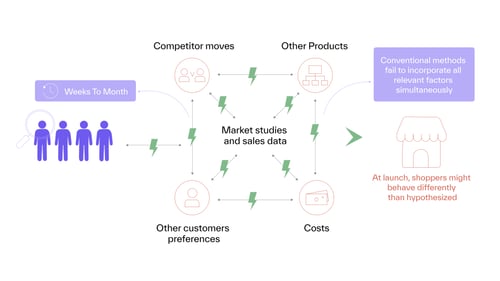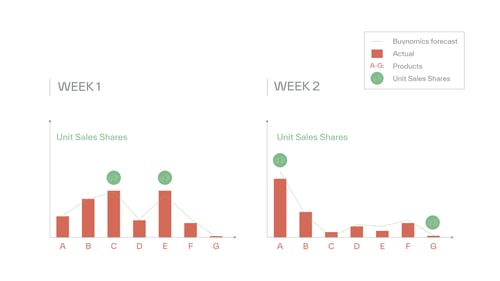Four Key Factors for Effective Trade Promotions
"25% off”
“On sale”
“Buy one, get one free”
Measured by their ubiquity, consumer packaged goods (CPG) companies cannot seem to survive without trade promotions.
Research shows this is true: 60% of the CPG marketing budget is allocated to trade promotions. However, they have become a necessary evil, as two-thirds of promotions do not break even.
Promotion optimization thus remains a huge potential for consumer goods companies.
The 3 Core Problems of Trade Promotions
Overall, designing promotions with beneficial effects is difficult. Currently, trade promotions have three core problems:
- Trade promotions do not reach their KPIs: 85% of companies struggle with overspending and cannot fully understand how to maximize their ROI.
- Trade promotions are neither predictable nor repeatable: Professionals too often lack market transparency and the ability to forecast. Only 12% of companies feel their analytical capabilities align with their trading partners.
- Trade promotions have counteractive effects: Only 33% of promotions break even. Moreover, excessive low-price strategies can result in brand dilution. It comes as no surprise that customer loyalty is especially low where promotions are very frequent.
The 4 Roadblocks to Successful Trade Promotions
What are the underlying drivers that cause trade promotions to be unsuccessful? Four key factors are undercutting the success of trade promotions:
A lack of data transparency impedes evidence-based decision-making processes. For promotions, transparency regarding one’s own prices at the point of sale and competitor prices is essential.
Unfortunately, it can be difficult to disaggregate sales channels, products, and their features.
Inconsistent execution across channels inhibits the application of valuable learnings from past promotions at scale. Sharing and scaling valuable insights across the organization is essential to sustain success and avoid a constant hit-and-miss approach.
Inadequate promotion scopes and frequencies can have detrimental effects on both short-term KPIs, such as revenue uplift, and long-term KPIs, like brand equity and profitability.
Incoherent methodology makes disaggregating all relevant factors that influence pricing decisions difficult. This can include changes in one’s product portfolio and competitors’ portfolios, price changes, and promotions.
With today's legacy toolsets, overcoming these roadblocks becomes exceedingly difficult. All too often, revenue and promotion managers rely on Excel models that are ill-equipped to solve the issues above.

Figure 1: Consumer insights without Buynomics is a long and incoherent process.
How Buynomics Addresses Trade Promotions’ Biggest Problems
✔️ Buynomics leverages machine learning and behavioral models to create a >95% accurate model of shopper behavior. This allows promotion managers to anticipate very accurately how their promotions will perform and thus enables the drivers of trade promotions’ success.
✔️ Buynomics combines different data sources into coherent and transparent insights. Products are always analyzed based on their individual components, allowing them to capture effects reliably if changed. The influences of different sales channels and competitors’ moves are also accounted for.
✔️ Buynomics can be used in various sales channels and for many products. Its intuitive and adaptive design allows for its application across the board, resulting in comparable and robust insights.
✔️ Buynomics can detect and avoid inadequate design and frequency of promotions before they are launched. Thanks to our Virtual Shoppers AI, managers can test unlimited price combinations and their effects on revenue and profit within minutes.
✔️ Simulations in Buynomics always follow the same principles and deliver transferable insights. Relevant data from various sources shape a single sample of Virtual Shoppers that mirrors the behavior of actual customers. Even if multiple factors inside or outside the managers’ sphere of influence change, the way of assessing their impacts remains coherent.
Using Buynomics for promotion planning instead of traditional tools directly impacts your business. Accurate forecasting across your channels makes meeting campaign KPIs much easier. Further, being predictable and repeatable greatly improves the efficiency of your promotions.

Figure 2: Buynomics forecasted how shoppers would react to two entirely different pricing scenarios with an accuracy of >95%.
Summary
Trade promotions are a double-edged sword: on the one hand they help gain temporary market share, on the other hand, most promotions do not generate any profits.
Even worse, shoppers get used to constant discounts, perceiving unnaturally low prices as the new standard. This undercuts both brand equity and shopper loyalty.
While abandoning promotions is not a viable option, they have considerable potential for improvement. Data transparency, consistent execution, coherent methodology, and adequate scope and frequency are four important prerequisites for successful promotions.
Buynomics, a SaaS-based platform, creates trade promotions that create actual value. Managers can test promotion designs with a sample of virtual shoppers that behave just like customers in the real world.
The effects on profit and revenue are instantly visible. Your competitor’s moves can be easily integrated into the analysis as well. Thanks to its unique capabilities, Buynomics helps to meet campaign KPIs and avoids unwanted effects.
Contact us today to learn more.

October 26, 2022
.png?width=520&height=294&name=Promotion%20blog%20image%202%20(1).png)
